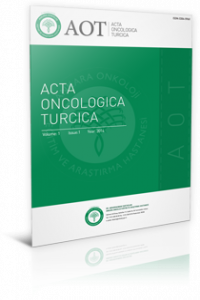The Comparison of the Incidence of Transierıt Neurological Symptoms Associated By Bupivacain and Ropivacain in Patients Undergoing Transurethral Resection with Spinal Anesthseia
Kelimeler: Spinal anestezi, postoperatif komplikasyon, geçici nörolojik semptom, litotomi pozisyonu, ropivakain, bupivakain.
Spinal Anestezi ile Transüretral Rezeksiyon Yapılan Hastalarda Bupivakain ve Ropivakaine Bağlı Geçici Nörolojik Semptom İnsidansının Karşılaştırılması
Spinal anesthesia, postoperative complications, transient neurologic symptoms, lithotomy position, ropivacaine, bupivacaine.,
___
- Freedman JM, Li DK, Drasner K, et al. Transierıt rıeurolojic symptoms after spinal anesthesia. Anesthesiology 1998;89:633-41.
- Ben-David B, Maryanovsky M, Gurevitch A, et al. A compa- rison of minidose lidocaine-fentanyl and conventional-dose lidocaine spinal anesthesia. Anesth Analg 2000;91:865-70.
- Yamashita A, Matsumoto M, Matsumoto S, et al. /4 compari- son of the neurotoxic effects on the spinal cord of tetracai- ne, lidocaine, bupivacaine, and ropivacaine administered intrathecally in rabbits. Anesth Analg 2003;97:512-9.
- Corbey MP, Bach AB. Transient radicular irritation (TRI) after spinal anaesthesia in day-care surgery. Açta Anaesthesiol Scand 1998;42:425-9.
- Hampi KF, Heinzmann-VVİedmer S, Luginbuehl I, et al. Transient neurologic symptoms after spinal anesthesia. Anesthesiology 1998;88:629-33.
- Keld DB, Hein L, Dalgaard M, et al. The incidence of transi ent neurologic symptoms (TNS) after spinal anaesthesia in patients undergoing surgery in the supin position. Hyperbaric lidocaine 5% versus hyperbaric bupivacaine 0.5% Açta Anaesthesiol Scand 2000;44:285-90.
- Zaric D, Christiansen C, Pace NL, Punjasawadwong Y. Transient neurologic symptoms (TNS) follovving spinal ana esthesia with lidocaine versus other local anaesthetics. Cochrane Database Syst Rev 2005;19:CD003006.
- Levin A, Datta S, Camann WR. Intrathecal ropivacaine for labor analgesia: A comparison with bupivacaine. Anesth Analg 1998;87:624-7.
- Kristensen JD, Karlsten R, Gordh T. Spinal cord blood flow after intrathecal injection of ropivacaine: A screening for neurotoxic effects. Anesth Analg 1996;82:636-40.
- KhawKS, Kee N, Wong Y, et al. Spinal ropivacaine forcesa- rean section. Anesthesiology 2001;95:1346-50.
- Gautier PE, De Kock M, Van Steenberge AV, et al. Intrathecal ropivacaine for ambuiatory surgery. A comparison between intrathecal bupivacaine and intrathecal ropivacaine for knee arthroscopy. Anesthesiology 1999;91:1239-45.
- Ganapathy, Sugantha FR, Sandhu, et al. Transient neurolo gic symptom (TNS) follovving intrathecal ropivacaine. Anesthesiology 2000;93:1537-40.
- Carpenter RL. (letter) Hyperbaric lidocaine spinal anesthesia: Do we need an alternative? Anesth Analg 1995; 81:1125-8.
- Hodgson PS, Neal JM, Pollock JE, et al. The neurotoxicity of drugs given intrathecally (spinal). Anesth Analg 1999;88: 797-809.
- Hampi KF, Schneider MC, Pargger H, et al. A sim Har inci dence of transient neurologic symptoms after spinal anest hesia with 2% and 5% lidocaine. Anesth Analg 1996; 83:1051-4.
- Pollock JE, Mulroy MF, Stephenson CA. Spinal anesthetics and the incidence of transient radicualar irritation. Anesthesiology 1994;81:A1029.
- Sakura S, Chan VW, Ciriales R, et al. The addition of 7.5% glucose does not alter the neurotoxicity of 5% lidocaine administered intrathecally in the rat. Anesthesiology 1995; 82:236-40.
- Hashimoto K, Sakura S, Bollen AW, Ciriales R, Drasner K. Comparative toxicity of glucose and lidocaine administered intrathecally in the rat. Reg Anesth Pain Med 1998;23:444-50.
- Casati A, Moizo E, Marchetti C, Vinciguerra F. A prospecti- ve, randomized, double-blind comparison of unilateral spi nal anesthesia with hyperbaric bupivacaine, ropivacaine, or levobupivacaine for inguinal herniorrhaphy. Anesth Analg 2004;99:1387-92.
- McDonald SB, Liu SS, Kopacz DJ, Stephenson CA. Hyperbaric spinal ropivacaine: A comparison to bupivacaine in volunteers. Anesthesiology 1999;90:971-7.
- Brattebo G, Wisborg T, RodtSA, et al. Is the pencil point spi nal needie a better choice in younger patients? A compari son of 24G Sprotte with 27G Ouincke needles in an unse- tected group of general surgical patients below 46 years of age. Açta Anaesthesiol Scand 1995;39:535-8.
- Wahedi W, Nolte H, Klein P. Ropivacaine for spinal anaest hesia: A dose finding study. Br J Anaesth 1994;72:164-9.
- Malinovsky JM, Charles F, Kick O, et al. Intrathecal anest hesia: Ropivacaine versus bupivacaine. Anesth Analg 2000;91:1457-60.
- ISSN: 0304-596X
- Başlangıç: 2015
- Yayıncı: Dr. Abdurrahman Yurtaslan Ankara Onkoloji EAH
Multidedector Computed Tomography Findings of Crohn 's Disease
Kaposi Sarcoma Presented on Glans Penis
Tolga TUNCEL, Ahmet ALACACIOĞLU, Bülent KARAGÖZ, Oğuz BİLGİ, Alpaslan ÖZGÜN, Zafer KÜÇÜKODA, Emin Gökhan KANDEMİR
Gülbahar GÜLNERMAN, Selma KELEŞ, Menşure KAYA, Neslihan KURU, Nihal KADIOĞULLARI
Ultrasonography Guided Pancreatic Needle Biopsies
Bilgin Kadri ARIBAŞ, Gürbüz DİNGİL, Ümit ÜNGÜL, Gürsel ŞAHİN, Dilek Nil ÜNLÜ, Kamil DOĞAN, Sevim ÖZDEMİR, Zekiye PEKOL ŞİMŞEK, Aliye Ceylan ZARALI, Rasime Pelin DEMİR, Kemal ARDA
A Case of Schvvannoma Arising from Brachial Plexus
Hayriye KARABULUT, Baran ACAR, Mehmet Ali BABADENİZ, Gülçin ŞİMŞEK, Emre GÜNBEY
Primary Lung Cancer vvith Invasion Into the Atrium: Two Case Report
Nazan ÇİLEDAĞ, Pelin DEMİR GÜMÜŞDAĞ, Elif AKTAŞ, Kemal ARDA
Clinicopathological Characteristics of Ninety MaHgnant Melanoma Patients
Mutlu DOĞAN, Ülkü YALÇINTAŞ ARSLAN, Saadet TOKLUOĞLU, Güze ÖZAL, Hande SELVİ, Güngör UTKAN, Hakan AKBULUT, Bülent YALÇIN, Necati ALKIŞ, Fikri İÇLİ
Thromboembolic Complications of Cancer and Management
Yeşim YILDIRIM, Özgür ÖZYILKAN
Renal Celi Carcinoma in an Ectopic Kidney: Case Report
Niyazi KARAMAN, Lütfi DOĞAN, Cihangir ÖZASLAN, Can ATALAY, Çiğdem IRKKAN, Asuman BOZKURT
Surgical Breast Biopsies and Complications: Is There an Effect on Future Treatments?
Lutfi DOĞAN, Niyazi KARAMAN, Cihangir ÖZASLAN, Can ATALAY, Mehmet ALTINOK
